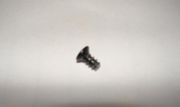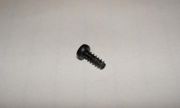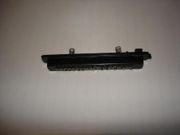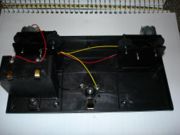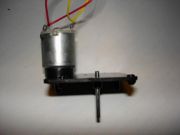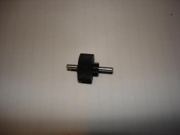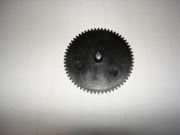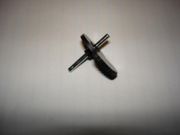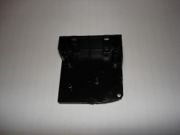Automatic card shuffler
From DDL Wiki
(→List of Parts) |
(→List of Parts) |
||
| Line 76: | Line 76: | ||
! Part # !! Part name !! QTY !! Function !! | ! Part # !! Part name !! QTY !! Function !! | ||
|- | |- | ||
| - | | 001 || Small Screws || 4 || Holds top plastic screen in place ||[[Image: | + | | 001 || Small Screws || 4 || Holds top plastic screen in place ||[[Image:Team04_SmallScrew.JPG|thumb|Small Screw]] |
|- | |- | ||
| - | | 002 || Medium Screws || 3 || Located on bottom of case in triangular formation, under the card tray||[[Image: | + | | 002 || Medium Screws || 3 || Located on bottom of case in triangular formation, under the card tray||[[Image:Team04_MediumScrew.JPG|thumb|Medium Screw]] |
|- | |- | ||
| - | | 003 || Large Screws || 8 || Located along other perimeter on botom of case, to hold case | + | | 003 || Large Screws || 8 || Located along other perimeter on botom of case, to hold case together/hold the gear train case ||[[Image:Team04_LargeScrew|thumb|LargeScrew.JPG]] |
|- | |- | ||
| - | | 004 || Clear Top Cover || 1 || Located on top of case in between decks provides slot for | + | | 004 || Clear Top Cover || 1 || Located on top of case in between card decks, provides slot for them to slide through. Also, keeps the rest of the deck in place while shuffling is in progress ||[[Image:Team04_TopCover.JPG|thumb|Clear Top Cover]] |
|- | |- | ||
| - | | 005 || Operating Button || 1 || Contacts metal piece beneath to complete circuit allowing both motors to operate||[[Image: | + | | 005 || Operating Button || 1 || Contacts metal piece beneath to complete circuit allowing both motors to operate||[[Image:Team04_OpButton.JPG|thumb|Operating Button]] |
|- | |- | ||
| - | | 006 || | + | | 006 || Circuit Wire || 5 || Setup in series and connected to the battery. Circuit completed when part 005 is pushed and held down ||[[Image:Team04_Wire.JPG|thumb|Circuit Wire]] |
|- | |- | ||
| - | | 007 || Motor || 2 || | + | | 007 || Motor || 2 || Initiates the power to make the gears rotate in order to shuffle the cards ||[[Image:Team04_Motor.JPG|thumb|Motor]] |
|- | |- | ||
| - | | 008 || Rubber Gripper || 2 || | + | | 008 || Rubber Gripper || 2 || Increases the friction force to grab the cards into the tray ||[[Image:Team04_RGrip.JPG|thumb|Rubber Gripper]] |
|- | |- | ||
| - | | 009 || Spur Gear|| 2 || | + | | 009 || Spur Gear|| 2 || Changes the direction of gear rotation and creates more torque||[[Image:Team04_Spur.JPG|thumb|Spur Gear]] |
|- | |- | ||
| - | | 010 || Offset Gear || 2 || | + | | 010 || Offset Gear || 2 || Makes contact with deck of cards from underneath ||[[Image:Team04_Sector.JPG|thumb|Sector Gear]] |
|- | |- | ||
| - | | 011 || Gear Case || 1 || | + | | 011 || Gear Case || 1 || Covers and protects the gear train mechanism ||[[Image:Team04_GCase.JPG|thumb|Gear Case]] |
|- | |- | ||
| - | | 012 || Battery | + | | 012 || Battery Compartment || 1 || Transfers the electrical power into mechanical power||[[Image:Team04_Batt.JPG|thumb|Battery Compartment]] |
|} | |} | ||
Revision as of 05:25, 19 February 2007
Contents |
Executive Summary:
The primary purpose of the Automatic Card shuffler originally was to take away the burden of one shuffling cards in a card game. What usually takes place in a card game is that players would take turns shuffling the deck of cards in order to rearrange the previous order that the cards were in. This action was to ensure that each player recieves an even hand when the cards are dealt out evenly. Now assuming that we live in an ideal world, the cards would be shuffled evenly so that neither player wouldn't have an unfair advantage. In reality the chances of the cards being shuffled evenly on a consistent basis are very slim. One factor could be the simple fact that some people cannot shuffler as good as others. Furthermore some people cannot not shuffle at all. As a result, there isn't really a pattern that the deck of cards follow after a person shuffles them due to human error. The Automatic Card shuffler serves if not to completely eliminate, then reduce this error as much as possible. This would be very important for a casino setting because players are not allowed to shuffle the cards. In this case the players wouldn't have to feel that the dealer is trying to cheat them because the card shuffler would eliminate that speculation.
Customer Needs/Requirements
There are certain customer needs which the automatic card shuffler should perform: speed of shuffling, battery life, the noise when shuffling and adequate level of mixing. It has to be carefully designed, as they can generate biased shuffles otherwise cards produced from automatic shuffling machines is the subject of considerable interest to both gamblers and casinos.
In terms of customer, we found that most of the users expect to save time from shuffling during the card game. In addition, for continuous use over the maximum amount of time the battery, the design of the automatic card shuffler needs to be light-weight, so the user can bring or move it when them personally from place to place. Easy to use is also one of the expectations from users. People use the card shuffler to save their time from shuffling (one or more decks), the procedure of working with product should take less effort than doing by hand. While the shuffler is processing, the sound produced by the shuffler needs to be as low as possible to ensure the game quality.
The automatic card shuffler mimicked people, cutting the deck and interlacing cards to perform riffle shuffles. Typically, an automatic card shuffler pulls cards one by one from the bottom or top of a deck and slides each card into one. Most of the card games require cards to be shuffled randomly which means the shuffler has to perform great randomness of final product. If the cards aren't properly shuffled and their distribution isn't truly random, the advantage could be even greater
List of Customer Needs and Product Requirements
| Rank | Customer Needs | Product Requirements |
|---|---|---|
| 1 | Easy to Use | Overall Design |
| 2 | Save Time | Speed of Processing |
| 3 | Randomness | Shuffling Design |
| 4 | Easy to Carry | Light Weight |
| 5 | Durability | Battery Life/Recharge |
Function:
- Shuffles cards (playing cards).
- Speed up the shuffling process.
- Shuffles cards for people who can't shuffle.
- Eliminates the possibility of someone cheating whiles shuffling.
- Stacks the cards nicely after shuffling.
- Speeds up the game (people don't have to take turns shuffling
Inputs/Outputs
- Cards (Inputs)
- Batteries (Inputs)
- Tray (Inputs)
- Shuffled cards (Output)
- Cards stacked neatly in tray (Output)
Use
- Place Batteries (2) in the card shuffler.
- set the card shuffler on the table.
- Set the card shuffler to where everyone can see.
- devide the deck of cards in half.
- place one half on the right of the card shuffler.
- Place the other half of cards on the left.
- Place tray in card shuffler.
- Tray goes in the bottom slot of the card holder.
- Press the button to initiate shuffling process.
- Botton located at the bottom in front of the tray slot.
- When shuffling is complete, remove tray and retrieve cards.
Different Use/ Use Scenarios
- Poker
- Spades (game)
- Speed (game)
- Parties
List of Parts
| Part # | Part name | QTY | Function | |
|---|---|---|---|---|
| 001 | Small Screws | 4 | Holds top plastic screen in place | |
| 002 | Medium Screws | 3 | Located on bottom of case in triangular formation, under the card tray | |
| 003 | Large Screws | 8 | Located along other perimeter on botom of case, to hold case together/hold the gear train case | Image:Team04 LargeScrew LargeScrew.JPG |
| 004 | Clear Top Cover | 1 | Located on top of case in between card decks, provides slot for them to slide through. Also, keeps the rest of the deck in place while shuffling is in progress | Image:Team04 TopCover.JPG Clear Top Cover |
| 005 | Operating Button | 1 | Contacts metal piece beneath to complete circuit allowing both motors to operate | |
| 006 | Circuit Wire | 5 | Setup in series and connected to the battery. Circuit completed when part 005 is pushed and held down | |
| 007 | Motor | 2 | Initiates the power to make the gears rotate in order to shuffle the cards | |
| 008 | Rubber Gripper | 2 | Increases the friction force to grab the cards into the tray | |
| 009 | Spur Gear | 2 | Changes the direction of gear rotation and creates more torque | |
| 010 | Offset Gear | 2 | Makes contact with deck of cards from underneath | |
| 011 | Gear Case | 1 | Covers and protects the gear train mechanism | Image:Team04 GCase.JPG Gear Case |
| 012 | Battery Compartment | 1 | Transfers the electrical power into mechanical power |
Functional Operations
Before we tested the card shuffler, we took it apart in order for us to see how the shuffler functions and made the following assumptions:
1. There are two gear train systems.
- One motor is driven by batteries, which in return powers the other motor.
- The two motors are connected to each other by two wires.
2. Each gear train has its own motor.
3. For syncronization, there are two modified gears, both of which have teeth on some portion of itself.
4. One of the modified gears has its teeth pointing down, while the other modified gear has its teeth pointing up.
5. We assumed this was important because when a person places cards on both the left and right side of the card platform, one card would be lifted up while the other would be touching the surface of the card platform.
6. The card that remains in contact with the surface of the card platform is carried by a fat gear that is driven by a motor when the user presses the shuffle button.
7. This motor is powered by two "C" batteries.
8. After this card carried into the center slot with the tray, the modified gears are now in alternate positions, and the same process is repeated for the other card on the other side of the card shuffler.
Design for Environment
Our major area about the impact of environment and the automatic card shuffler are batteries and the plastic body decompositions after throwing away.
In order to run the current automatic card shuffler, users will need to insert two "C" batteries. Most users will choose the non-rechargeable batteries to save the cost. After using for couple times, we need to buy and change another two batteries. Batteries contain hazardous materials that may get into the environment. For example, cadmium and lead enter soil and water from landfills and enter the air via municipal waste incinerators. Recycling the batteries has become an issue to normal users since it is not as easy as a can of soda. Batteries can be recycled at the household Waste collection facility which may not be convenient for most users. This will result people just throw it directly without recycling. Using the automatic card shuffler without batteries will be a positive impact for the environment.
After users decide not to use the automatic card shuffler and throw it away, that is another potential to takes up space in landfills and become harmful to environment. Since plastics are so durable that they will not rot or decay as do natural products such as those made of wood. As a result great amounts of discarded plastic products accumulate in the environment as waste. It also presents the additional problem of being difficult to burn. We think by using the better material to help by producing less pollution is an important are for our product
Failure Mode and Effects Analysis
The following chart emphasizes the most sever failures that can occur with the product. Although none of these failures could cause a complete termination of the functionality of the product, they would cause the user to become completely dissatisfied with the product, thus coercing the user to stop the usage of the card shuffler. The point of this analysis is to ensure that the user is free from as many annoyances that would cause he /she to stop using the product.
| Item & Function | Failure Mode | Effects of Failure | S | Causes of Failure | O | Design Controls | D | RPN | Recommended Actions | Responsibility & Deadline | Actions Taken | S* | O* | D* | RPN* |
|---|---|---|---|---|---|---|---|---|---|---|---|---|---|---|---|
Motor
| Electrical failures: Motor may not output consistent power | Product shuffles cards in an inconsistent pattern resulting in uneven shuffling. | 7 | Poor brand of motor. Poor connections between the motor and the wires. | 7 | Extensive testing in various conditions because environment setting could play a role | 3 | 147 | More effort in making more secure connections. Integrate better motors | Motor Manufacturer | N/A | 7 | 5 | 3 | 105 |
| Mechanical Failures: Wear & Tear. | Loud noise and inefficient shuffling of cards . | 7 | Heat generation causing the teeth in the gears to deform and shear away at each other | 2 | Test in various conditions and record temperature with thermocouples | 6 | 84 | Change arrangement of gears to reduce power input required of motor | Motor manufacturer | N/A | 6 | 2 | 5 | 60 | |
Gear train
| Gear train is not snugged fit. Loose gears. | Gears produce loud noise that is intolerable for the user. | 8 | Broad range for the dimension tolerance. | 8 | Run the gears to check for wobbling | 6 | 384 | Reduce the tolerance range for the teeth dimensions of the gears | Manufacturer | N/A | 5 | 6 | 5 | 150
|
Gear Train Case
| Vibration on the card shuffler | Wobbling of gears because the entire gear train set is vibrating. | 7 | Case not secure to the base of the card shuffler. | 7 | Test to see required force to hinder vibration | 5 | 245 | Glue the gear case to the base | Manufacturer | N/A | 7 | 5 | 3 | 105 |
Conducting Wire
| Unsteady power output | Inconsistent rotating of the gears. | 5 | gauge size of wire may not be sufficient enough. | 7 | Test with different wire types | 3 | 105 | Use bigger gauge of wire | Motor Manufacturer | N/A | 4 | 6 | 3 | 72 |
